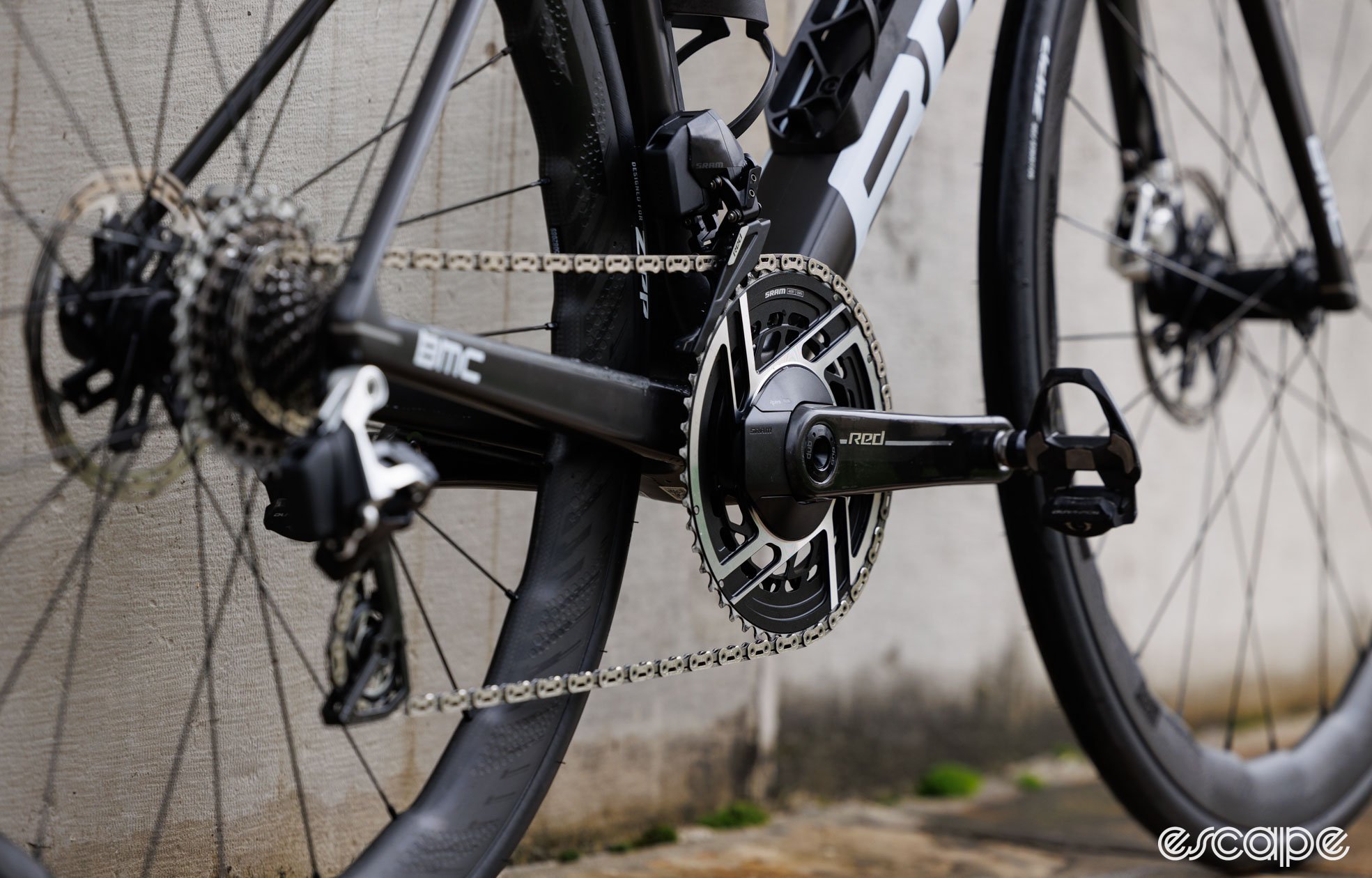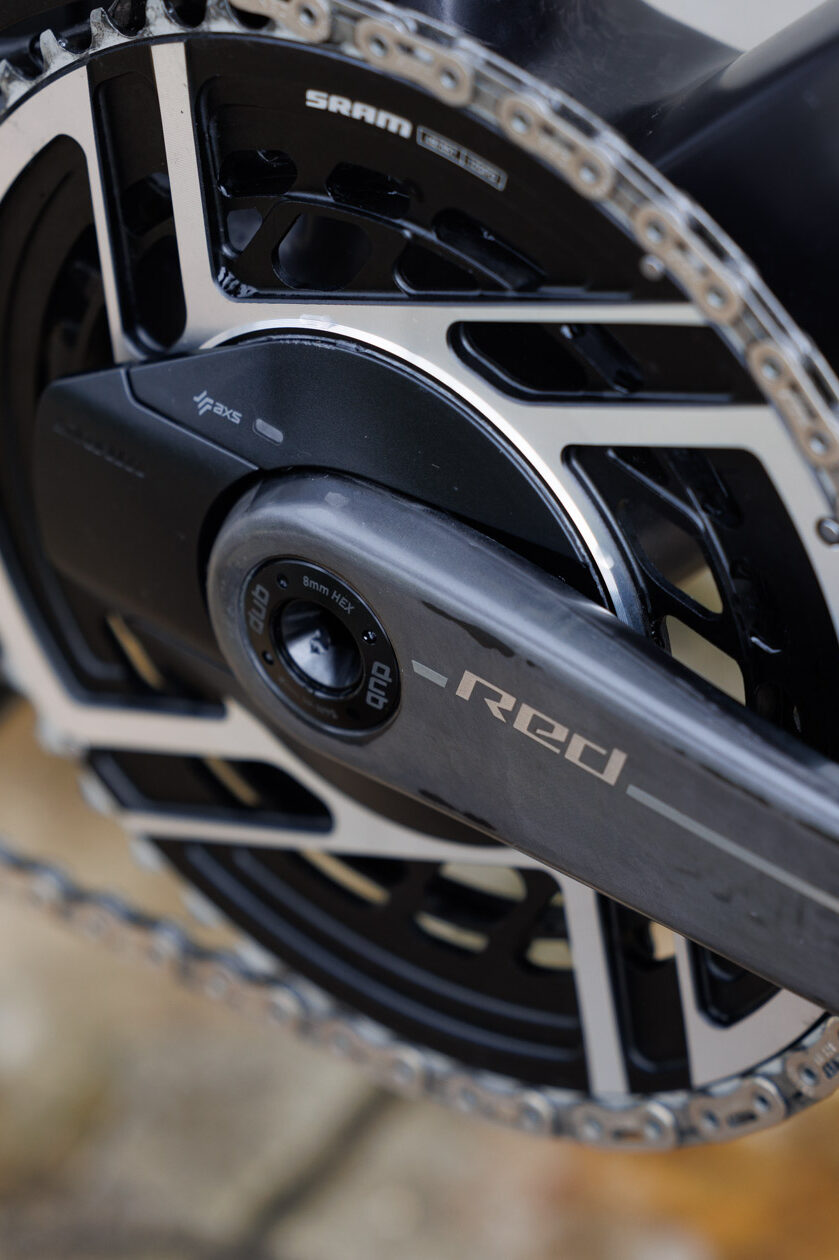It’s a poorly kept secret at this point, but today, SRAM officially unveiled the next generation of its Red AXS road groupset. Direct-mount rear derailleurs, 13-speed, a new battery, and mineral oil brakes – the new SRAM Red AXS has none of that.
Instead, this new flagship road groupset keeps each piece entirely backward compatible with pre-existing SRAM AXS 12-speed road groupsets. Want to fit the new Red shifters to your Rival AXS bike or get the new front derailleur for your first-gen Force AXS? Yep, you can do that. And while the new parts won’t revolutionise road cycling, they offer an ergonomic improvement, set what I’d argue is a new benchmark in drop-bar braking, and shave some weight.
With nearly two months of riding on the new components, we have a full breakdown of what’s new, what isn’t, and how it all performs. If you currently own an SRAM AXS bike or are in the market for something new and premium, this review is for you.
In addition to this review, we recorded a podcast with some key people of the SRAM team to discuss the finer details and design choices behind the new groupset. That podcast also includes a separate interview with the design and engineering team of Hammerhead (now an SRAM-owned company) to discuss the new Karoo computer that too has launched today. Along with the new Karoo, we have a separate article covering the accompanying new handlebar from Zipp, and a new partnership tyre with Goodyear.
The short of it: SRAM’s latest flagship road groupset. It’s still 12-speed, uses DOT brake fluid, and is powered by the same AXS batteries. Now disc-brake only, lighter, and with 100% backward compatibility to previous-gen 12-speed road groupsets.
Good stuff: The brakes are vastly improved and set a new benchmark for dropbar bikes, wider gearing and shorter crank options, more premium aesthetic, lightest electronic groupset option (in stock configuration), familiar and now even easier setup, power numbers remain trustworthy, no changes for the sake of.
Bad stuff: Powermeter is still integrated with chainrings, new levers lengthen your reach, shifting is not noticeably quicker than before, front derailleur is still fussy to setup (although better than before), small dead spot in brake lever travel, as expensive as before (but no more).
Jump to a section:
- The big updates
- The iterative updates
- What’s old
- Weights and pricing
- Installation
- Riding the new Red AXS
- Red AXS versus Dura-Ace R9200
- What’s next?
The big updates
The new SRAM Red AXS offers a number of big changes, some more subtle ones, and a few things that are largely the same. In some cases, these iterative updates are related to SRAM’s desire to keep every single piece of the new Red AXS groupset cross-compatible with pre-existing 12-speed AXS road components.
Another big theme to the new Red AXS is that it’s now disc-brake only. It’s another loss for #savetherimbrake, however, backward compatibility with previous-generation rim brakes and shifters does keep the options on life support.
Branding-wise, SRAM has ditched the “eTap” from the name. The previous generation is known as Red eTap AXS (D1 in product codes), whereas this new range is simply Red AXS (E1 in product codes). Similarly, you’ll no longer find Quarq’s branding on the powermeter.

Ok, time to discuss what received the biggest overhaul: the shifters and brakes. A quick glance at the shifters reveals a new approach to ergonomics with a hood shape that is now lower in profile, slimmer in the hand to allow more finger wrap, and a smidge elongated for improved palm support.
This new hood shape is facilitated by a complete restructure of the hydraulic brake master cylinder. The previous vertically oriented pull piston is now replaced by a master cylinder piston of the same size that runs horizontally through the lever and works in a more efficient push direction.

Combined with a higher-placed lever pivot point and a few tweaks to the caliper, SRAM has truly transformed the effectiveness and feel of its brakes, with much attention given to braking from the hoods. How much better can it be? Compared to the previous generation, the American company claims the new system requires just 1/5th of the effort when braking from the hoods, and 1/3rd of the effort when in the drops. Equally both the lever throw and power are more linear than before. You can bet that I’ll return to this later in the review.
Many expected SRAM to make the move to mineral oil as they’ve done in a couple of the brand’s mountain bike brakes, however, new Red AXS instead sticks with DOT 5.1. “We still believe DOT is the highest performing of the options. I wouldn’t say in the future that we’ll never go mineral oil on the road, but you have to look at backwards compatibility and when you’ll make a generational change. It just wasn’t the time to make a change to mineral oil,” explained SRAM’s Category Director for Road, Paul Kantor, in our bonus Geek Warning episode.
There are no changes to the brake pads, however, the two-piece calipers to host them are visibly different. They’re now stiffer, lighter, and with a smidge more pad clearance to reduce the chance of rotor rub. Meanwhile, SRAM claims to earn a little more brake power for the same lever effort by raising the location of the piston in relation to the pad. This effectively increases the brake force applied to the outer edge of the rotor. The company states the change is subtle and not enough to introduce uneven pad wear.
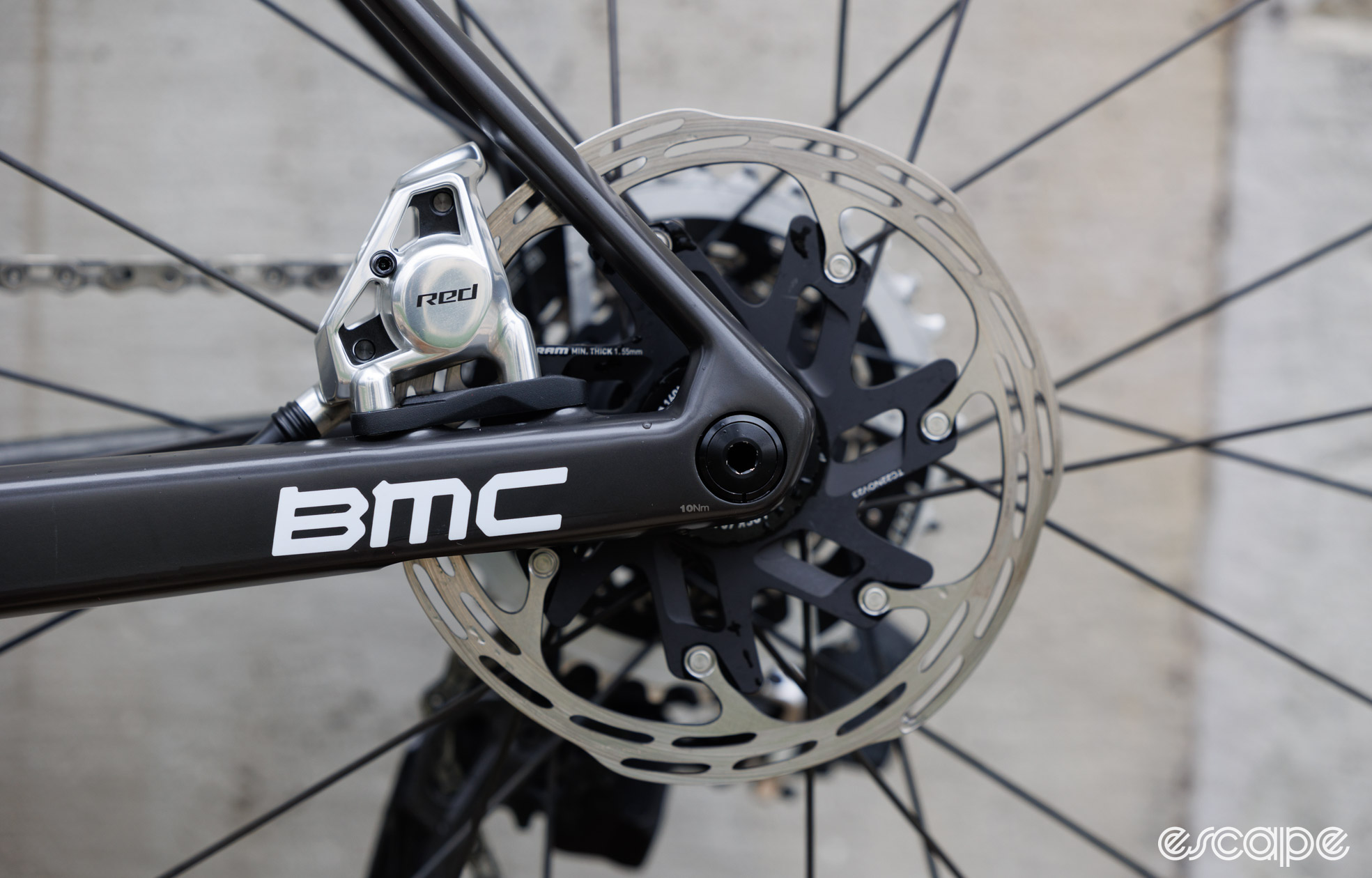
The brakes are accompanied by new-looking rotors that come with no claims of improved braking performance, noise reduction, or the like. They’re a smidge lighter, limited to Center Lock attachment, and available in 140 or 160 mm sizes.
The approach to shifting remains unchanged from SRAM’s initial entrance into electronic road groups with eTap. Each hand is given one shift paddle that’s responsible for shifting the rear derailleur in the opposite direction. Meanwhile, a front shift is actuated by pressing both left and right shift buttons simultaneously. Each shifter is still powered by a CR2032 coin battery, which is claimed to last approximately two years between replacements.
SRAM has reshaped the paddles to be longer, more textured, and with more angular shaping to prevent the dreaded finger pinch under braking. Additionally, there are now “Bonus Buttons” on the inner top of the hood. Placed in a more accessible position than Shimano Di2’s top button, the Bonus Buttons are set up out of the box to act as a secondary shift point. Alternatively, they can be configured to control ANT+-enabled head units (such as the new Hammerhead Karoo, or modern Wahoo and Garmin devices). Add in the optional AXS wireless Blips (stick-on shift buttons you can place just about anywhere) and there are now more shift point options than ever.

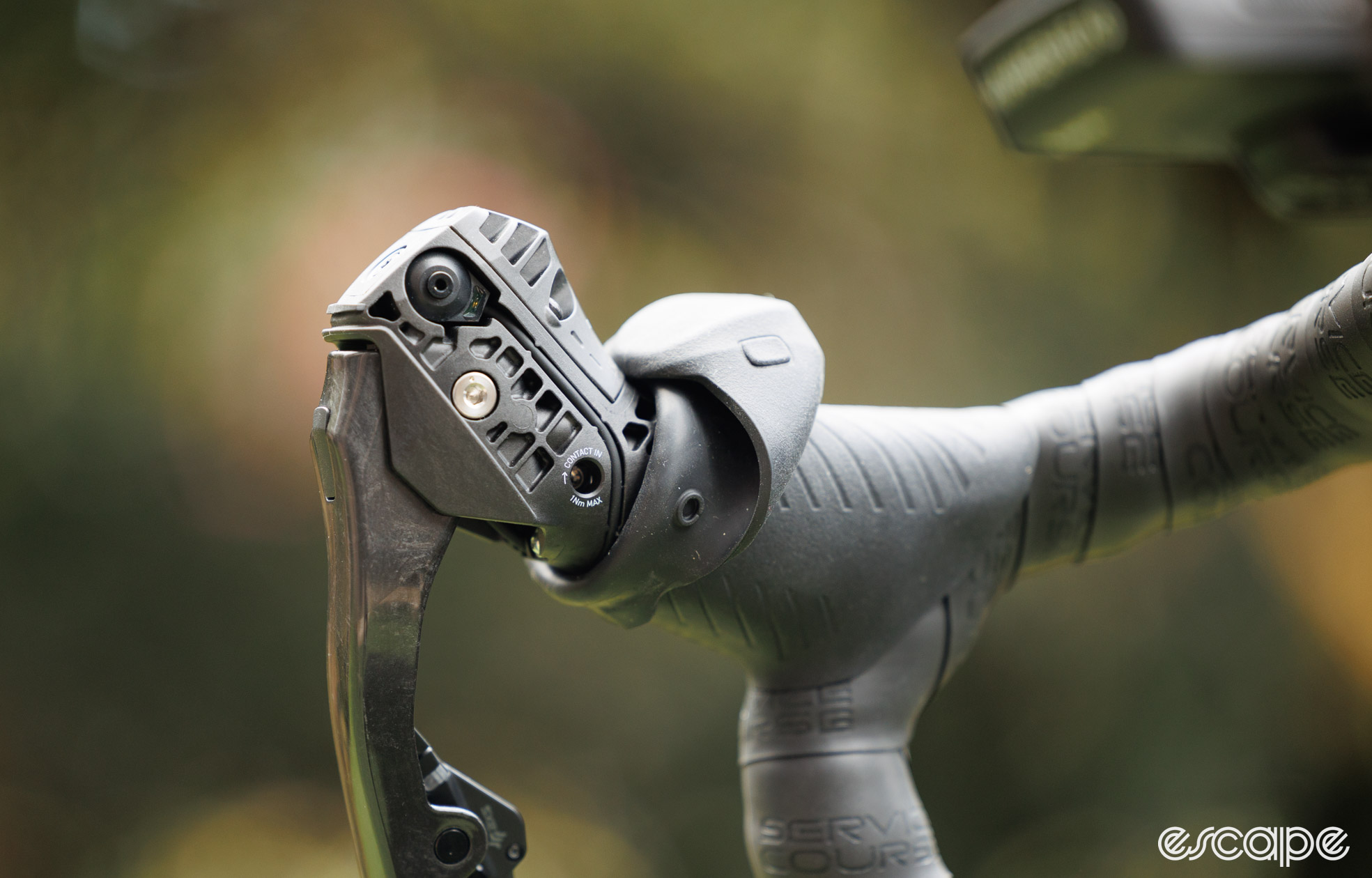
Other details in the hoods include a more shapely lever blade with a small amount of outward flare to better align with current trends in handlebar shapes. Pad contact and lever reach adjust remain, with the former being a feature that’s now exclusive to Red-level parts. There are some cool details here that I’ll get to shortly.
The iterative updates
The new brakes and shifters certainly steal the show, but the derailleurs and crank arms also earn some desirable updates.
SRAM’s front derailleurs have earned a troublesome reputation over the years, with a large part of the blame in falling on a design that leaves little room for poor setup or adjustment. Aiming to solve such issues, the new Red AXS front derailleur has a few features to simplify the installation and improve chain security.
The derailleur cage is reshaped and narrowed to improve security and shifting speed, and it’s now specific to the 45 mm chainline recommended for disc-brake road bikes. And for the first time in AXS history, SRAM has added an auto-trim feature into the derailleur to accompany the angled Yaw design (where the cage doesn’t sit straight to the chainring in order to improve chain clearance). Simplifying the setup is a new installation tool that was designed alongside the creation of the derailleur (more on this in the installation section).

The trim works by moving the front derailleur cage when more extreme gears are chosen. This automatic trim feature doesn’t move the derailleur as much as Shimano’s Di2 but instead allows you to set the derailleur a bit more tightly to the chain with less risk of it rasping. For those wondering, the trim feature is built into the derailleur and is not a firmware update. However, to reiterate, the new derailleur will work with pre-existing AXS groups if you’ve been struggling with setup to date.
The updates to the rear derailleur are more aesthetic and weight-relieving, with machined details in the aluminium construction left unpainted to tie it all together with the new crankset. There’s now just a single option of rear derailleur that is officially compatible with cassettes ranging from 10-28T through to a generous 10-36T size, and for use with 1x or 2x gearing. Additionally, the derailleur has gained a larger 14T lower pulley wheel, and both spin on ceramic bearings. SRAM claims this larger pulley wheel matches current aesthetic trends, but I’d argue it also helps to marginally reduce frictional losses. Visually the new lower pulley wheel looks like the Magic Wheel from SRAM’s Transmission derailleur, but I can confirm it does not have the same rotating feature, so please don’t go sticking a hex key through it!
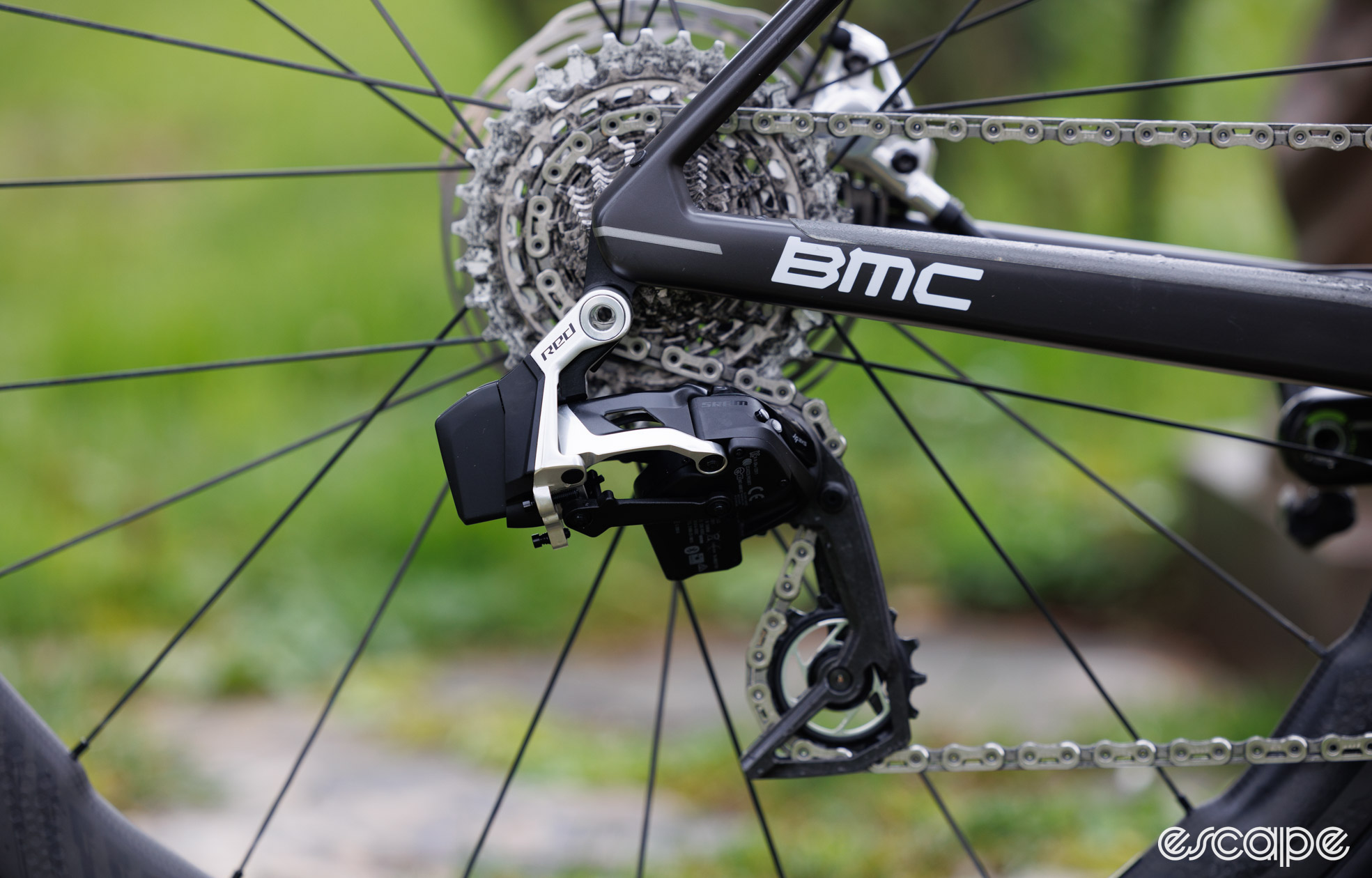

There are no changes to the servo motors that make the derailleurs move. It’s business as usual for the removable AXS batteries which power the derailleurs’ approximately 60 hours of ride time. And the Orbit clutch for improved chain retention continues unchanged. While that means no significant changes to shift speed, SRAM has optimised its wireless protocol for more reactive timing between the shifters and rear derailleur. In the past, the rear shifting could be made faster by unassigning the simultaneous press function from the shifters (required for front shifting), something you’d only do if running 1x gearing. According to SRAM, the updated protocol has sped up the rear derailleur reaction speed when in a 2x configuration, although it’s still not quite as quick as if running a dedicated 1x setup.
The new carbon crank arms look enough like the previous generation that SRAM’s sponsored riders have apparently already won two Grand Tours on the things. The changes are largely internal with a revised carbon layup that saves further weight from the already light arms without a detectable loss in stiffness. SRAM also expanded its range of crank lengths, now starting at just 160 mm in addition to the 165, 167.5, 170, 172.5, and 175 mm options.
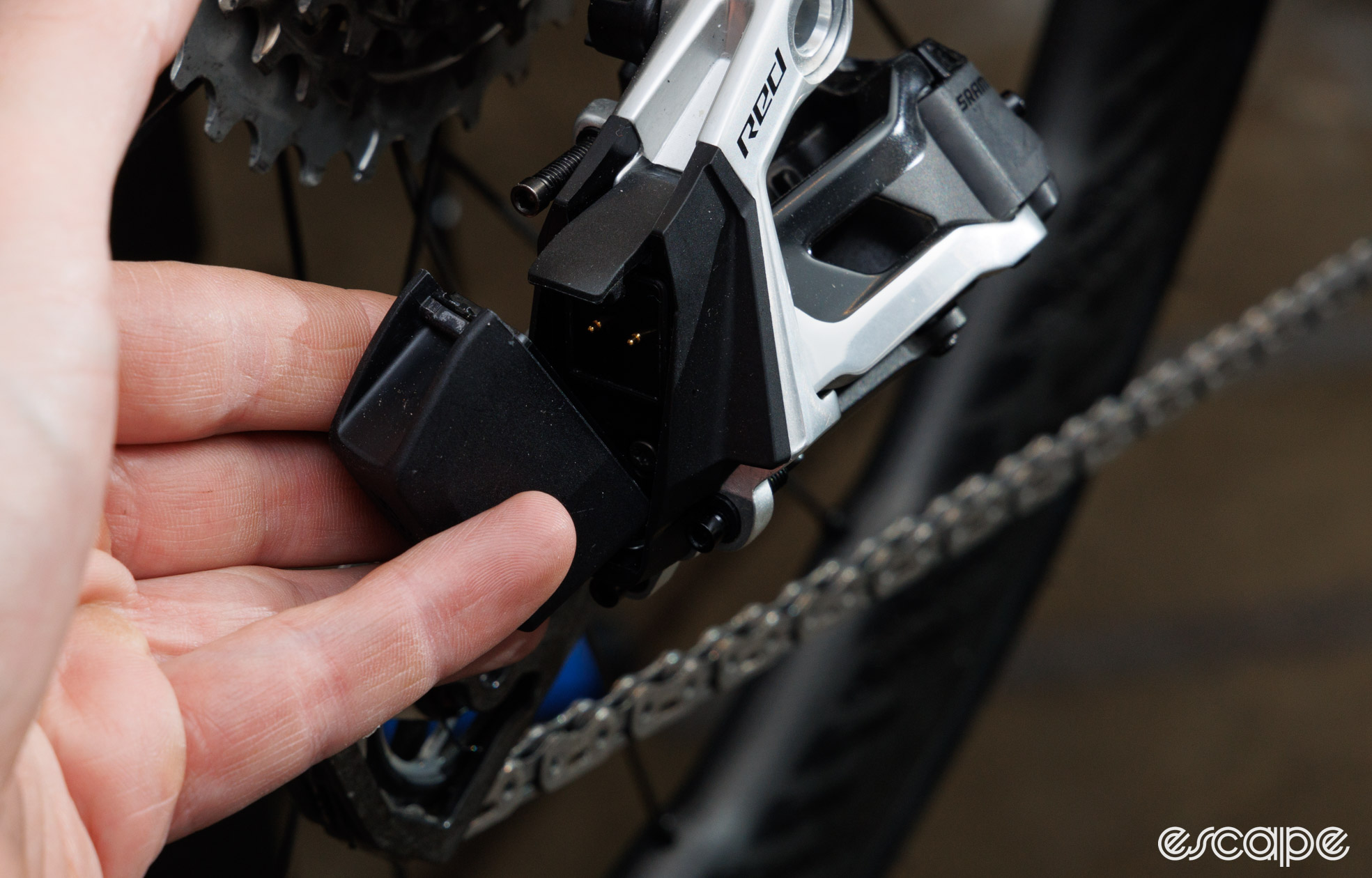
With polished brake calipers, details on the rear derailleur, and new chainring style, it’s clear that SRAM is still doing its part to bring silver back into trend. Add to that the more subtle graphics and the whole groupset carries a more premium aesthetic than before.
What’s old (or close enough)
SRAM’s impressively light and machined cassette carries over largely unchanged except for the blackened backside to the biggest cog. New 10-30T and 10-36T options sit alongside the preexisting 10-28T and 10-33 sizes. Meanwhile, the previously available 10-26T cassette is discontinued and isn’t officially recommended for use with the new rear derailleur, although I suspect only weirdos will be upset by that. As before, all of these cassettes require an XDR freehub body for fitment.

All the previous size options of chainrings carry forward with mostly an aesthetic update and a few fewer grams. Stock power-equipped and non-power 2x cranksets will be offered with a choice of 46/33, 48/35, and 50/37T rings. Meanwhile, bigger rings will be available separately in 52/39, 54/41, and 56/43T sizes. All of these sizes use the same front derailleur which offers two different mounting holes for height setting. Just note that there are two different sizes of setup tool.
Meanwhile SRAM continues to offer power-equipped and non-power 1x cranksets, with a 50T narrow-wide chainring as stock, and other sizes available separately.
Speaking of the chainrings, SRAM is continuing with its design of permanently bonding the powermeter spider to the aluminium chainrings. This was a contentious issue with the previous generation (now including the current Force AXS), and I’d hoped to see SRAM adopt a similar threaded-ring system to what they’ve recently introduced to mountain bikes with XX SL. Alas, no such luck.
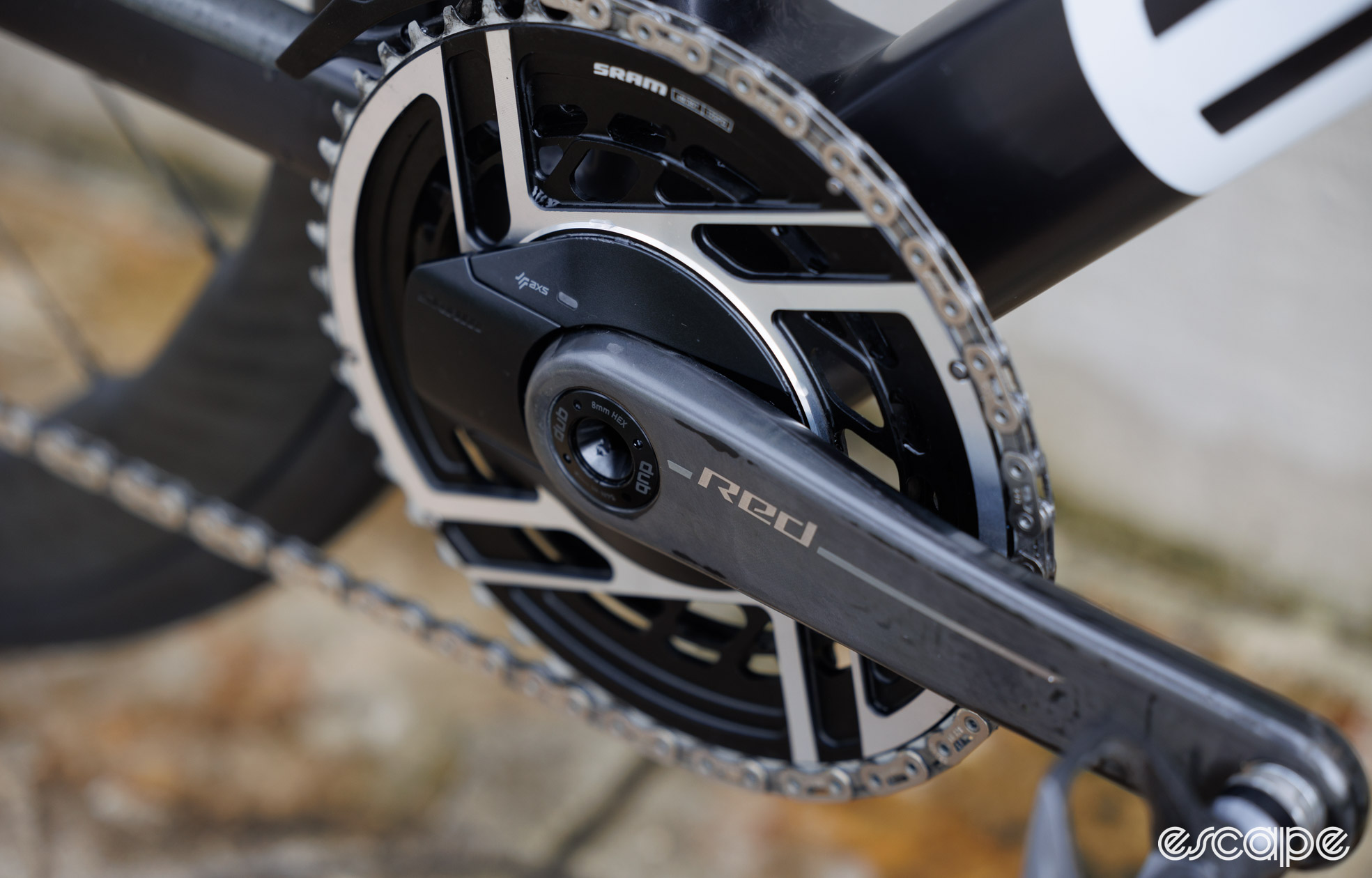
“For the double chainrings, this still allows us to make the highest performing and lowest weight option,” explained Kantor in the recording of the Geek Warning episode. ”Anytime you can eliminate an interface, you have better accuracy and reliability.”
While I’m not excusing its wastefulness, the left-and-right calculating powermeter spider/ring assemblies have a proven track record for trustworthy data (claimed +/- 1.5% accuracy) and good longevity from the easily replaceable CR2032 coin battery. Through dealers (bike shops), and in many countries, SRAM offers a 50% discount on a replacement unit should your rings wear out. Discount or not, these are expensive, and so it pays to use a good chain lube and keep things clean.
The cranks are otherwise the same once you get beyond the rings and lightened crank arms. The spider is still the 8-bolt variety, the spindle is still SRAM’s 28.99 mm DUB, and there are no changes to the bottom brackets.
With more holes than a Swiss cheese factory, the now lighter Red chain sticks with SRAM’s Flat Top shaping and Hard Chrome treatment. Not to go on too much of a tangent, but this new chain is effectively identical to SRAM’s T-Type XX SL chain from its flagship mountain bike group. And of course, this new Red chain, like everything else here, is backward-compatible with previous AXS 12-speed road groups.
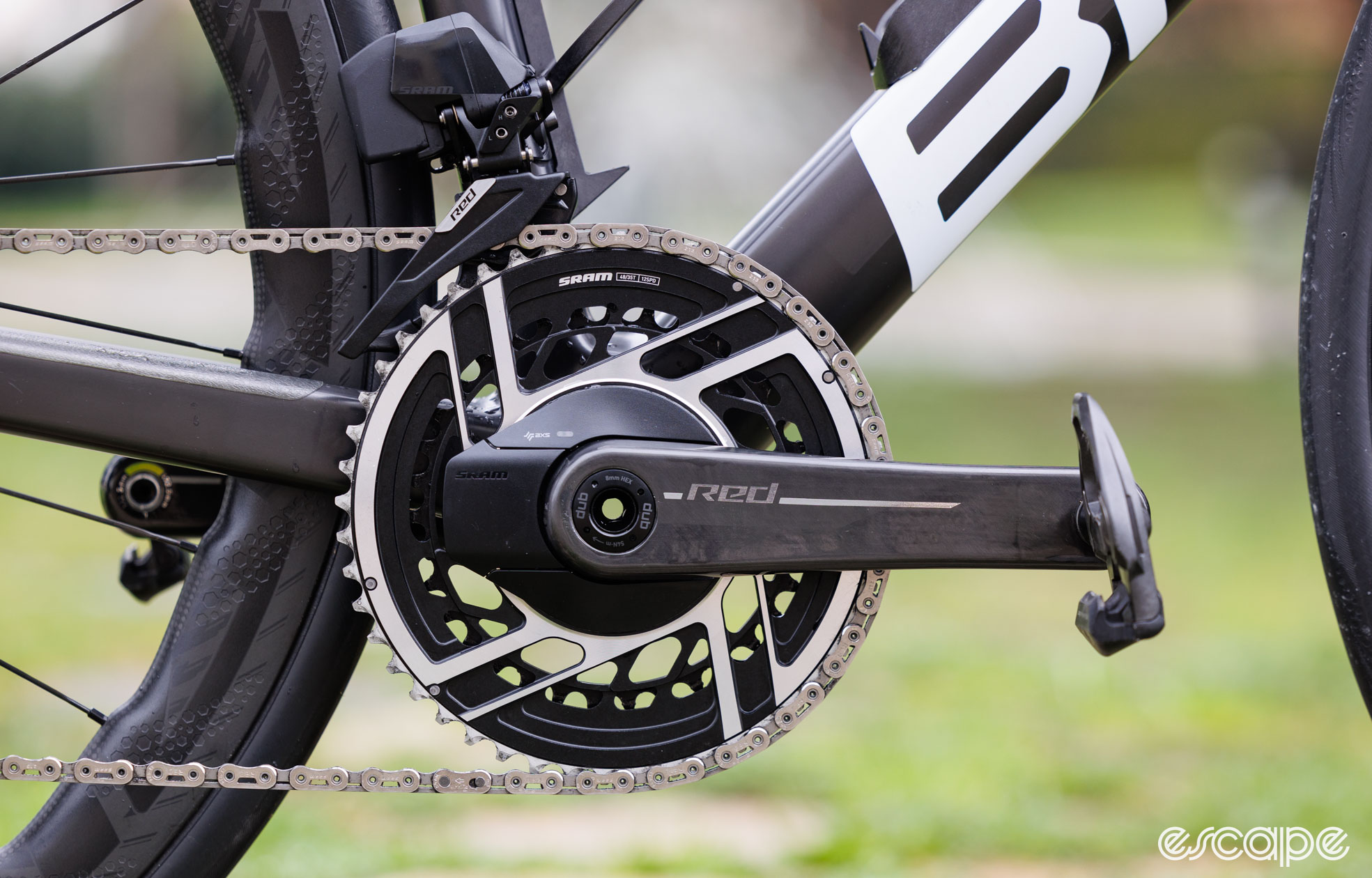
Want more than black and silver in the group? Previously a pro-only option, SRAM is now offering its new chain and all sizes of its red cassettes in the oil-slick rainbow colour for an approximate 10% price increase over the standard silver option.
Weights and pricing
I’ve teased it so far, but just about every new component in the group saves weight from its predecessor. The result is a combined weight saving of approximately 150 grams in a common configuration compared to the Red AXS eTap it supersedes. Adding to this, the new Red AXS is now the lightest in its category of electric shifting and hydraulic disc brake groupsets.
| New SRAM Red AXS | Previous SRAM Red AXS | SRAM Force AXS | Shimano Dura-Ace R9200 | |
| Crankset (non-power versions) | 545 | 574 | 708 | 678 |
| Cassette, smallest option | 180 | 181 | 232 | 223 |
| Chain, 114 links | 236 | 249 | 260 | 242 |
| Brake system (including calipers, hoses, and levers) | 689 | 772 | 784 | 680 |
| Disc rotors, 160 mm, pair | 280 | 288 | 272 | 230 |
| Front derailleur | 173 | 173 | 180 | 94 |
| Rear derailleur | 286 | 302 | 325 | 215 |
| Wires and battery | Included with derailleurs | Included with derailleurs | Included with derailleurs | 73 |
| Total | 2,389 g | 2,539 g | 2,761 g | 2,435 g |
Much of the weight reduction comes from the overhauled shifters and brake calipers, which together account for an 83-gram saving (excluding rotors). The next biggest drop is 29 grams in the crankset, with 16 grams removed from the rear derailleur and 13 grams stamped out of the chain.
The weights provided are for cranksets without power. As tested, my power-equipped crankset tipped the scales at an impressively light 576 g (172.5 mm, 48/35T). Compared to Shimano, SRAM greatly gains back grams with its crankset, chain, and cassette (more grams are shaved with the XDR freehub, too) but then loses elsewhere.
Price-wise, a package 2x groupset that excludes the crank and cassette but has everything else, including a Hammerhead Karoo, will retail for US$3,000 / €3,350 / £3,000 / AU$5,155. While it will vary from region to region, I mostly see prices roughly on par or marginally less than where the previous generation of Red AXS was priced. You can find individual component prices in the table below. Note that there are some minor variances, for example, the largest 10-36T cassette adds US$20, and rainbow-coloured pieces are more again.
| Part | USD | Euro | GBP | AUD |
| Red XG-1290 cassette | $390 | €435 | £390 | $670 |
| Red chain | $89 | €100 | £90 | $155 |
| Red AXS front derailleur, without battery | $450 | €506 | £450 | $775 |
| Red AXS rear derailleur, without battery | $700 | €785 | £700 | $1,205 |
| Red AXS shifter, brake caliper, and hose, left side | $675 | €755 | £675 | $1,160 |
| Red AXS shifter, brake caliper, and hose, right side | $675 | €755 | £675 | $1,160 |
| Paceline X disc rotor, each | $70 | €80 | £70 | $120 |
| Crankset with powermeter (double or aero single rings) | $1,200 | €1,345 | £1,200 | $2,065 |
| Crankset with no power (double or aero single rings) | $700 | €785 | £700 | $1,205 |
| Chainring kit, aero single | $240 | €270 | £240 | $515 |
| Chainring kit, double ring | $300 | €335 | £300 | $415 |
| Powermeter chainring kit (double or aero single rings, no crank arms) | $800 | €895 | £800 | $1,375 |
Installation further simplified
Thanks largely to the complete lack of wires and seamless wireless syncing, SRAM’s AXS groupsets already offered the fastest installation of its competitors, and this new group makes things even easier. And with the exception of the new US$7 front derailleur setup tool (included with the derailleur), there are no new tool requirements for installing Red AXS.
The biggest improvements are seen in the front derailleur with a plastic tool that securely clicks into the cage and sits onto the big ring – it was specifically designed alongside the new derailleur (unlike the previous version of this tool). From here the derailleur height and angle is set as you tighten the braze-on mounting bolt. And yes, there are still alignment markings on the derailleur cage should you choose to do the setup without the tool.
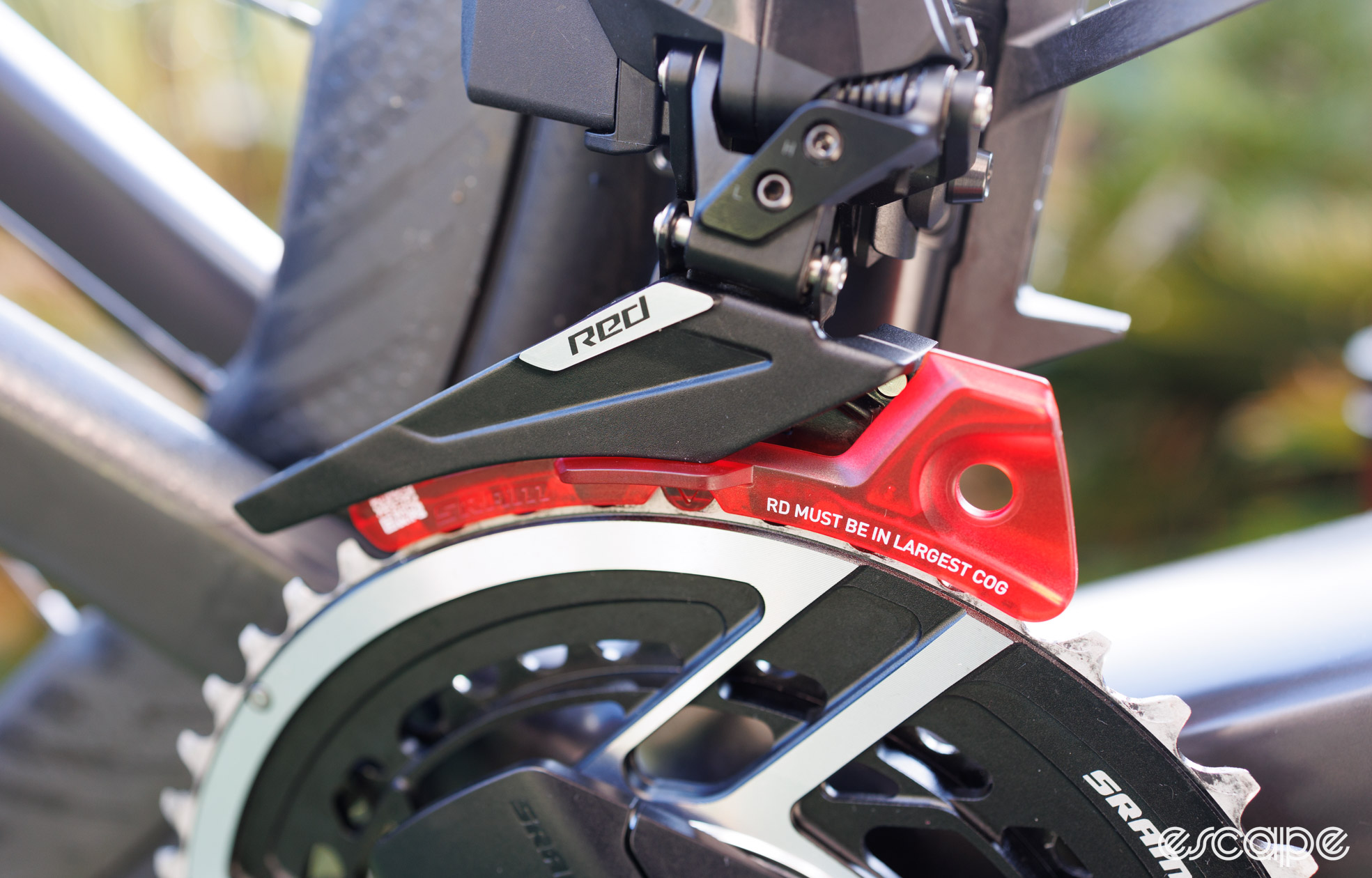
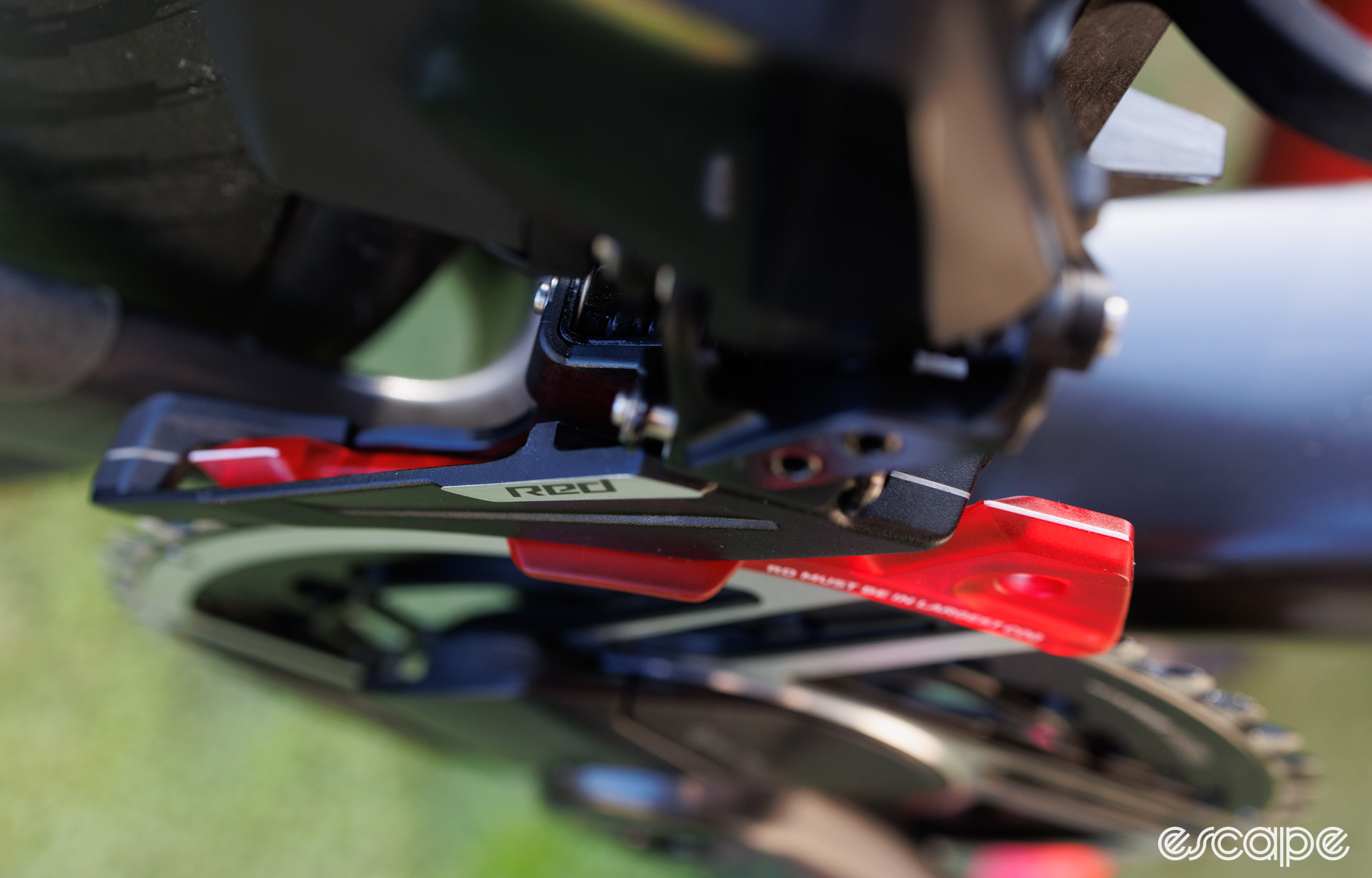
Another welcomed update for the front derailleur is seen with new support wedges that are now bolted in from the front side. With three shapes to choose from, these support wedges are SRAM’s answer to giving the derailleur a solid backing to reduce flex or unwanted movement in the front derailleur mount (braze-on). Where Shimano Di2 just uses a simple grub screw, SRAM derailleurs have previously used an assortment of wedges that bolt in from the backside of the derailleur and are a nuisance to install on frames with aero profiled seattubes. It’s a small but arguably overdue improvement.

More front derailleur improvements include the clearly marked low and high limit screws, and the already mentioned auto-trim feature (which I wish was more active than it is). Meanwhile there are no changes to the setup of the rear derailleur, and I’m not complaining.
Using the same clean-and-easy Bleeding Edge bleed kit fittings as before, the new brakes require no new tricks or tools. The increased pad gap in the caliper makes it easier to achieve rub-free running. My favourite improvement is the relocated lever adjustment bolt that is now at the front of the lever blade and covered by a small plug – now you can adjust it with just about any 2.5 mm hex tool. The pad contact adjustment has also moved to the inner side of the lever body, and now has four pre-set settings to choose from (although it’s trickier to figure out which setting is which).
Setting the shifter/lever angle is easier than ever thanks to a clever little detail. SRAM has designed its new shifter shape to be set at a 7-degree angle (though run yours how you like). To assist with this baseline setting, the new textured rubber hood cover has a pattern that sits horizontally to the ground when the intended angle is met. Meanwhile, the pattern on top of the hood cover is intended to be set 90-degrees to the bar for proper lever angle. Certainly a smart detail.
There are lots of great details here, but I had hoped by now SRAM would have figured out how to prevent its aluminium DUB crank bolts from galling (getting stuck). These bolts remain a prick to remove even after being installed with a torque wrench. Changing the bolt to a heavier steel version is known to help, but it remains a tough pill to swallow on such a premium-priced product where you’re paying for grams saved.
Riding the new Red AXS
On the road (or even in the shop), the first thing you’ll notice is how amazingly light the brake lever action is. SRAM’s claim of it being 1/5th of the effort from the hoods may sound far-fetched, but the number seems about right given the night-and-day improvement. Pull on the lever and it’s almost as if a caliper isn’t connected – it’s that easy on the fingers.
“I love how light and snappy the brakes are – finally!” Escape’s global tech editor James Huang exclaimed about his experience with the revised brake design. “Hey SRAM, now make all of your brakes feel like this, eh?”
One-finger braking is standard practice in mountain biking, but braking from the hoods on drop-bar bikes can feel insufficient. SRAM’s new brakes are now truly, and rather easily, operable with a single finger from the hoods. The difference is so vast that I immediately missed this light action upon returning to the current Force AXS brakes on a gravel bike.
Playing with a digital force gauge between the Red AXS and Force AXS systems, the latter required nearly three times to load just to get the lever moving, and that difference became even more extreme at the bite point. The combination of the light action and improved lever feel in Red AXS replaces my previous drop-bar brake benchmark of Shimano GRX Di2 (11-speed).

By comparison, braking from the drops always gives you the full leverage length of the lever and therefore is always less of issue with any brake system. Still, that light action and more linear power just makes it easier to feel what the brake is or isn’t doing. Meanwhile, the subtle hook to the end of the lever gives a comforting home for your index finger. Again these aren’t wholly original or revolutionary things, but are certainly welcomed.
Curiosity got the better of me, and so I swapped brake calipers between bikes fitted with new Red AXS and Force AXS (released in 2023). What the swap confirmed is that the light action and more linear power are almost entirely attributable to the new shifters. I’m sure the updated brake calipers assist in the improvement, but my testing suggests it’s not an obvious difference.
The brakes set a new benchmark, but I still found them to have more of a dead spot in the lever travel than I’d ideally want (where you can pull the lever slightly without slowing). I thought the pad contact adjustment would help solve this, but it seemingly could only be adjusted in the opposite direction of what I sought to achieve. That said, James didn’t find this to be the case, rather simply praising them for the strong initial bite, well-defined contact point, and great modulation.
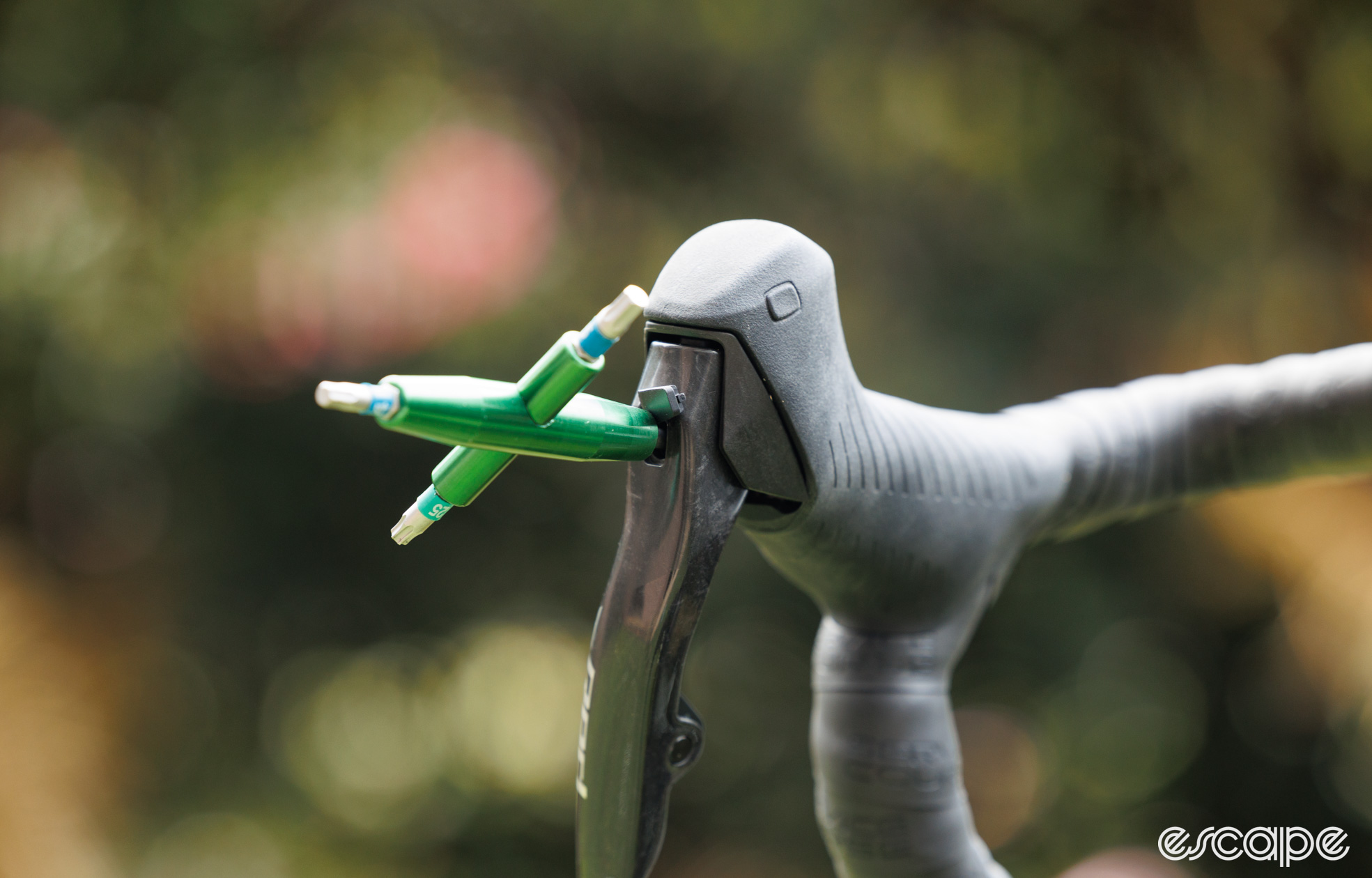
The new lever shape will please most, and I found it most beneficial when riding in an aggressive position or climbing out of the saddle. “It’s super comfy to stretch out on the hoods in an aero position, and it’s easy to wrap three fingers around the body whereas before you could only comfortably fit two,” said James.
I also want to give SRAM kudos for absolutely nailing the rubber hood cover. It’s grippy, a little bit cushy, and yet has an absolutely rock-solid fit to the composite shifter body beneath. Some rubber hoods can feel like they’re shifting around between your hand and the shifter, but not these.
That said, it’s not quite perfect. I’ve spent far too long pondering whether the new shifter body increases the bike’s effective reach (similar to using a longer stem or bar reach). It sure looks like it does. It also feels like it does with my medium-sized hands now fully supported by the hood cover. A ruler suggests the start of the lever hump is a further 5 mm away, but then this new shape is intended to be placed at a more upward angle and encourages your hands to sit further back. Hours of thought later and I still can’t determine exactly how much longer it is, but I can confirm that it marginally adds to the bike’s reach. I suspect many users will be oblivious to this; it may even be a positive for some and arguably a negative for those who already feel a little stretched.

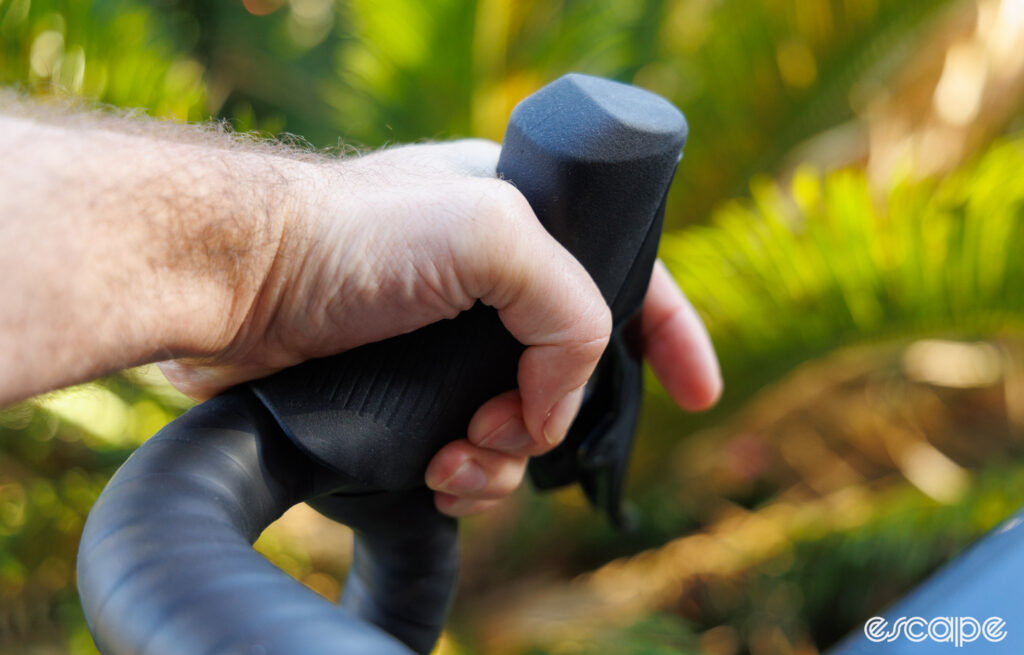

The new bonus buttons are the other point of contention. They’re set in a position that’s easy enough for an extended thumb to reach, whether in an aero position (on the hoods) or climbing out of the saddle. However, they’re covered by the thick rubber hood that greatly hides the tactility of the button. “The buttons are small and hard to find by feel – and that’s without wearing gloves, mind you – and the action is super vague with almost no noticeable click. In other words, I love the idea, but am pretty disappointed in the execution,” said James. And while I agree with James and think there’s room for improvement, I still found myself using them when climbing out the saddle, and am thankful that they’re of a design that you’d never press by accident.
My test bike was assembled with matching wireless Blips beneath the aero tops (there are dedicated indents for them in the new Zipp SL80 Race handlebar). Here I had three shift buttons to choose from on each side of the handlebar, and with such options, the original paddles soon only saw use on descents or sprints. If the Blips weren’t factory-sealed units without user-replaceable batteries, I’d want them on every AXS drop-bar bike.

Pressing any of the provided shift buttons reveals a rear shift speed that is hardly detectably better than before, and still obviously more delayed than Shimano’s latest. And with no shaping changes to the chain or cassette, shifting under power is still met with more of a clank compared to Shimano’s smooth click. The hollow cassette construction plays the biggest role here, but the chain construction and shifting ramps are culprits, too. Either way, not once did it miss a shift and while individual shifts still have a few microseconds of delay, shifting multiple gears by holding down the button is ultra-rapid.
Front shifting is now improved and has a more positive feel, with James praising it for being fantastic both up and down, even under power. My experiences were a little more mixed, and while I’ve found the shifts to the big chainring to be great, I’ve found the chain reluctant to drop off the big ring when put under strain.
Adding to this, the new front derailleur, despite its improvements, still has a tiny adjustment window. I initially experienced a little rasping of the chain in the easiest gear combination, and while that was tuned out, I eventually experienced a dropped chain (off the inside). Admittedly I’d spent weeks shifting it like an asshole coaxing it to fail, and one dropped chain in over a hundred high-power attempts isn’t bad. Either way, the front shifting is now really good, but for me, it still fails to push Shimano off the top step on which it has long stood.
Red AXS or Dura-Ace R9200?
It’s a big question. Allow me to try to answer it succinctly.
Weights, pricing, and even road performance are now so closely comparable between Shimano and SRAM’s best that they’re effectively even. Where the differences lie is in how the systems are powered, whether absolute accuracy from a matching powermeter matters, what gear ranges you seek, and a large dose of personal preference.
At the top of that list is a matter of true wireless versus semi-wireless. Shimano Dura-Ace now has wireless shifters, but the derailleurs are still wired to a central battery. SRAM earns points in using no wires, being simpler to install, and allowing easy battery charging away from the bike. SRAM’s AXS batteries never seem far away from needing charging (tip for AXS owners, get yourself a spare battery and leave it charged and next to your bike), while Shimano’s central battery provides such superior runtime that many users forget it needs occasional charging.
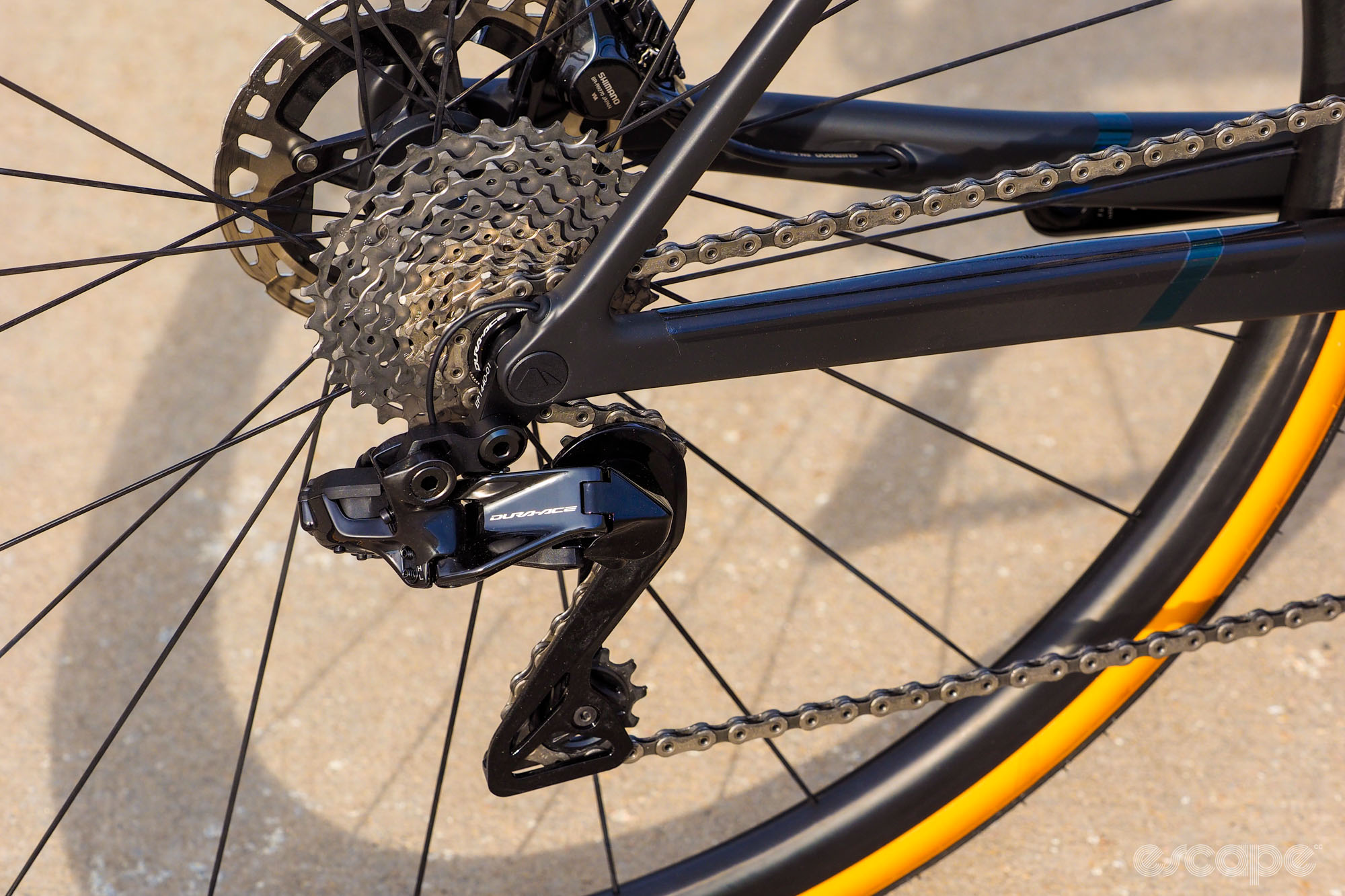
Wireless things introduce a new age of complexity, and SRAM deserves praise for keeping things dead simple and providing an app that just works. The AXS mobile app offers a great user interface with easy access to button customisation, battery checks, and firmware updates. Shimano is seemingly years behind in this regard.
Not everyone cares about absolute powermeter accuracy (clearly, including most of the WorldTour), but SRAM has a rather stellar reputation in this area. By comparison, Shimano has repeatably dropped the ball in fixing its left-to-right balance issues. There’s more to consider than just a powermeter, and while I don’t like that SRAM still integrates its unit into wear-based chainrings, it is the unit I trust more. Put another way, with what I know, I wouldn’t buy a current powermeter from Shimano, but I would buy a SRAM/Quarq.

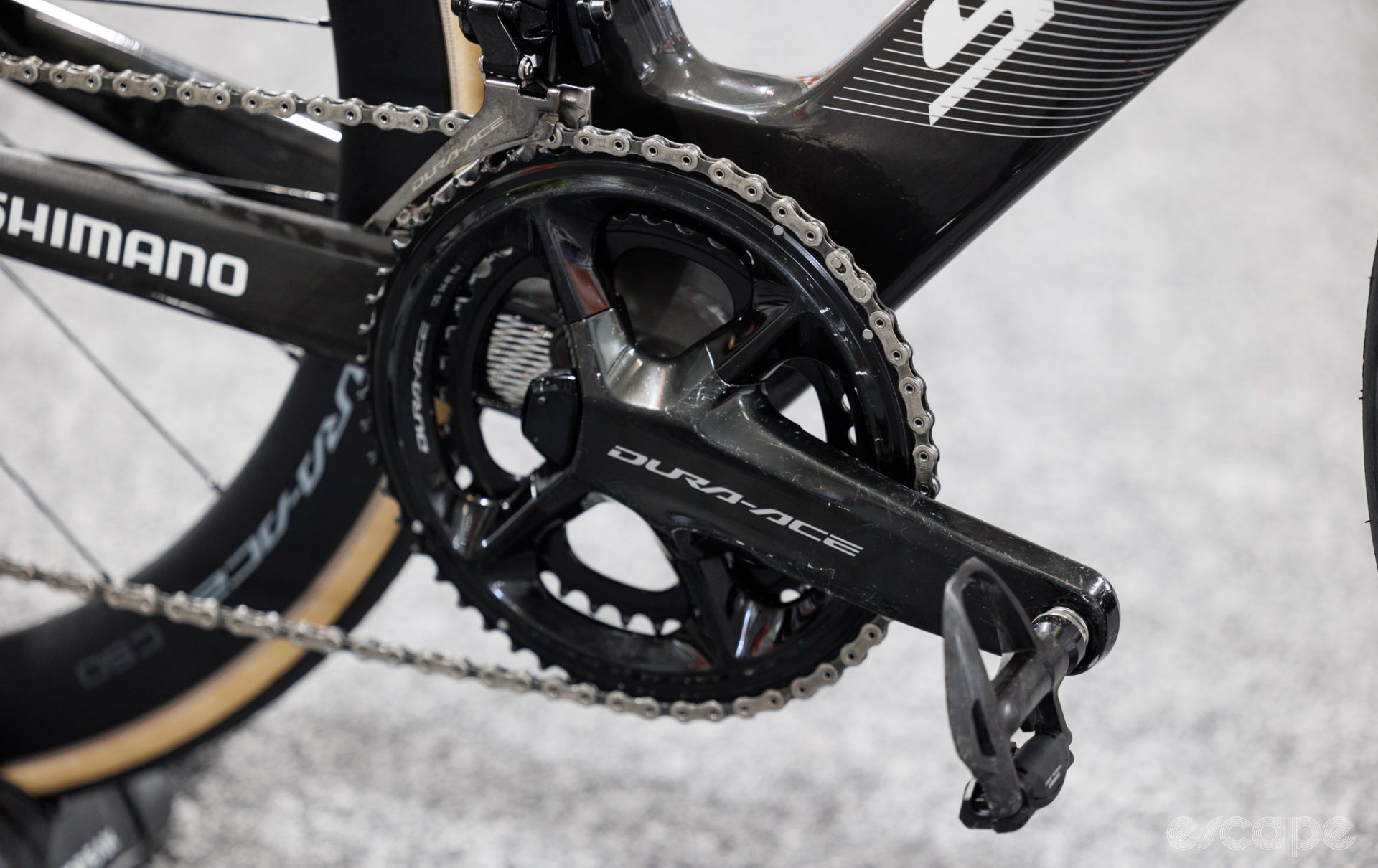
SRAM wins in terms of gearing options, notably lower gearing options for the aging and/or wider-tyre users among us (bigger tyres increase effective gear ratios). The addition of a 10-36T cassette that can be combined with 46/33T chainrings is sure to appeal to many. Meanwhile, SRAM isn’t ignoring options for the fast and fit riders who want to race. Add to that the clutch mechanism in SRAM’s rear derailleur and new Red wins if you were building an all-road style bike. Still, there is also the marginal gains debate over 10T (SRAM) versus 11T (Shimano) cog efficiency, but I won’t beat that tired horse any further.
While it doesn’t make a difference against the clock, Shimano remains the benchmark for shifting speed and smoothness. It’s long been said that nothing beats a Shimano front shift, but frankly, nothing beats its road bike rear shifting either.
SRAM’s Hard Chrome chains set the benchmark for durability the last time Zero Friction Cycling did such a controlled test (something I exclusively covered back at the Old Place). It’s not unheard of to see 20,000 km (or more!) of use from a single SRAM chain of this level if regularly waxed. That said, other independent tests have shown SRAM’s tight-tolerance chains to run a fraction slower when new, and my experience has been that they feel a tad rough through the pedals for the first thousand or so kilometers. By comparison, Shimano chains are wonderfully smooth from the first pedal stroke but won’t last quite as long.
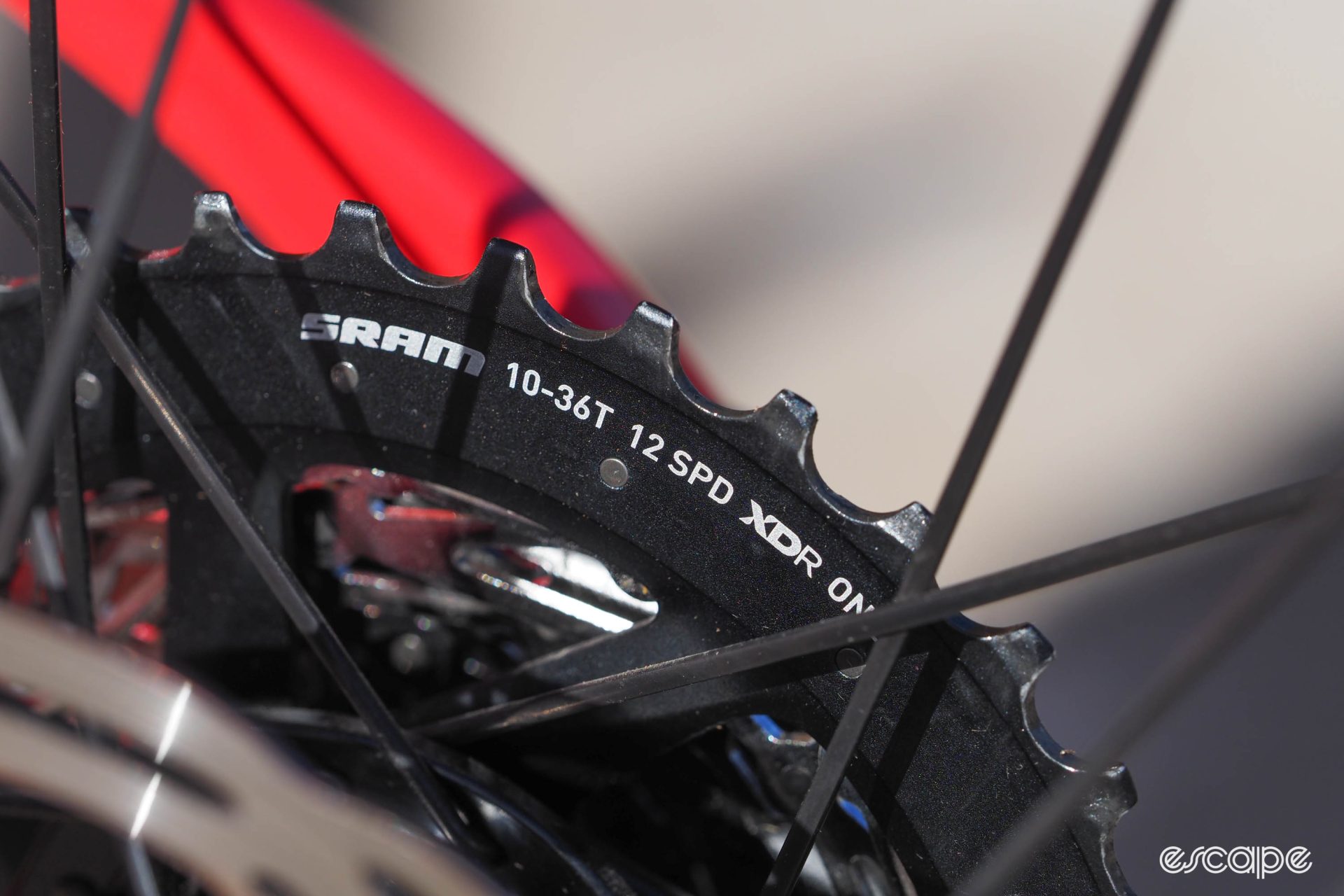
Lastly, there’s just the personal preference element. Some people like Toyotas, others like Fords, and some like neither. Both companies offer shifters that should prove comfortable for most users, but there are obvious differences in the exact shape and method of shifting. The brakes have a different feel, although I do think the new Red is better. And obviously, they’re aesthetically different, too.
In the end, both James and I agree that Shimano’s central battery system requires less ongoing intervention, and that remains a big plus in a world where it can often feel like we’re working for our devices. Still, both Red AXS and Dura-Ace R9200 are brilliant, each with highs and lows, but fundamentally, the debate largely boils down to a choice between wireless or semi-wireless. This is a topic James Huang and I discussed further (and without sitting on the fence) in an episode of the Geek Warning podcast.
What’s next?
From the release of this new Red AXS, it’s clear to me that we’re still a few years away from seeing any revolutionary and perhaps disruptive changes to SRAM’s road groupsets. Instead, new Red AXS represents a number of modest but needed updates without introducing any further compatibility complications to the range. I wouldn’t be surprised to see these same changes trickle to SRAM Force, and just for a giggle, my fingers are crossed that it coincides with next year’s May 4th (Nerd! – Ed.).
Clearly, the road market has been given a few more years to prepare itself for a radical change such as SRAM’s T-type direct-mount rear derailleurs, a concept that is now commonplace on mountain bikes and rumoured to soon be coming to gravel. Equally, the fact that this release almost glosses over 1x options has me hugely curious about what may be in store for future wide-range single-ring road setups.
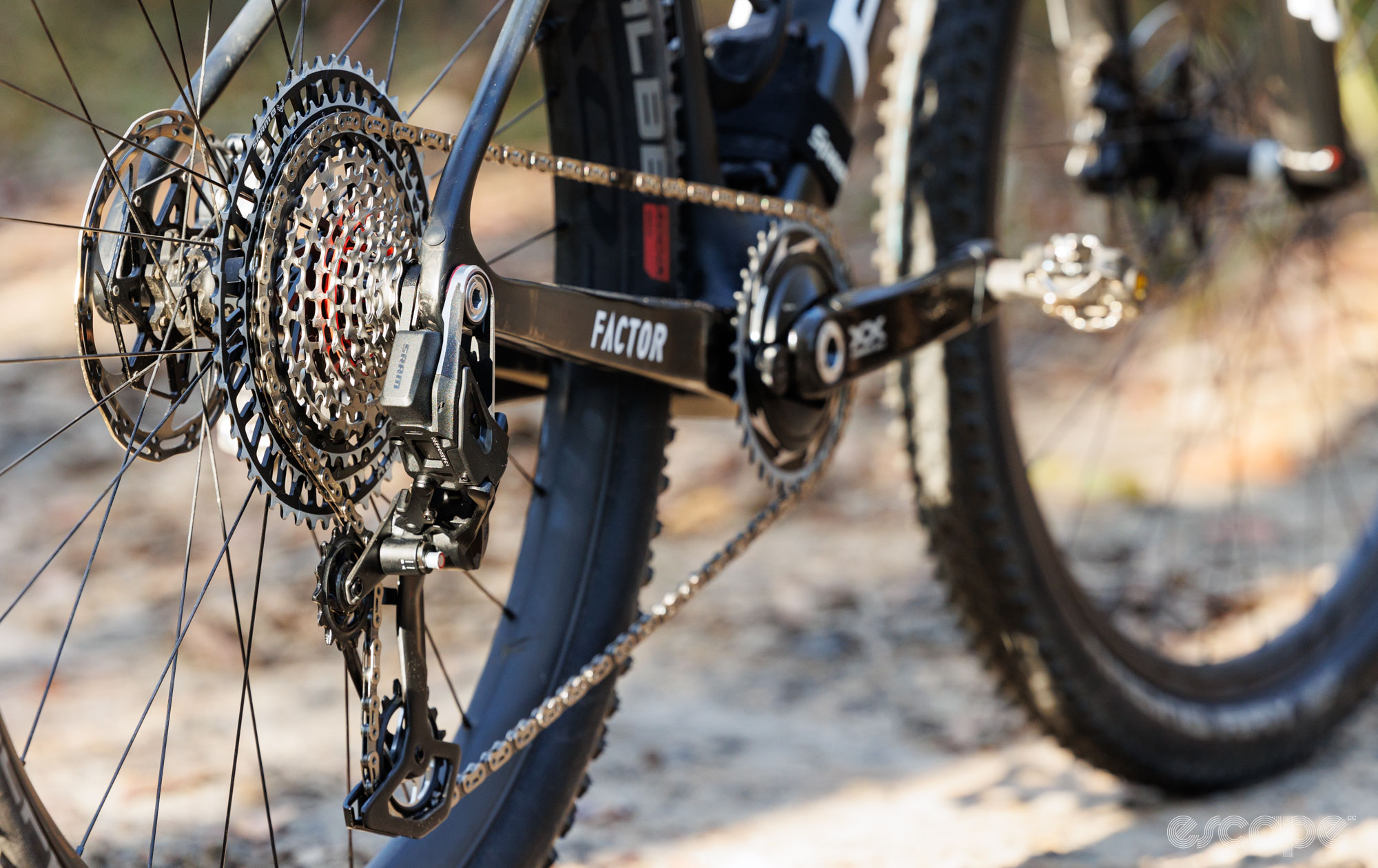
New SRAM Red AXS is by no means groundbreaking, and for tech nerds, the updates may be viewed as lacklustre and playing it safe. That said, I believe the American company has done just enough to remain the worthy and clear opponent to Shimano’s Dura-Ace. And if I haven’t already made it clear in the previous 76 mentions, I’m extremely happy that the new components work seamlessly with those before it.
In the end, the changes aren’t enough for me to suggest ditching your pre-existing SRAM AXS groups or consider not buying an older group on close-out. However, whether you ride road or gravel, the greatly improved braking sure makes an upgrade to the new shifters and brake calipers a worthy consideration.
Want more? SRAM has also released a matching handlebar in the Zipp SL80 Race, a computer in the Hammerhead Karoo, and some race tyres intended for its carbon hookless wheels. Don’t fret, it’s just a quick report of those.
Disclosure: SRAM covered flights, accommodation, and meals for the media launch event related to this product. Following the event I was sent home with a bike on loan to continue testing the new parts. The company also provided a chain wax that I reviewed back on April 1st (yes, it really was provided by SRAM, but it was also just a candle).
What did you think of this story?
